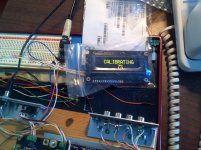James, you're right -- I've found mention of the power supply being problematic and putting a stiff 15V supply right at the board would help.
I'm afraid I can't take the time now to do any major mods to the output as described by you and George. I do have a 15V 5A power supply lying around here somewhere and I can certainly give it a try.
I was using foobar2000 with the wasapi plug-in so Windows was out of the picture. And I use asio with the M audio board so Windows is out of that picture, too.
Glad to hear the board arrived. Have you encountered any surprises or problems yet? First impressions?
I'm afraid I can't take the time now to do any major mods to the output as described by you and George. I do have a 15V 5A power supply lying around here somewhere and I can certainly give it a try.
I was using foobar2000 with the wasapi plug-in so Windows was out of the picture. And I use asio with the M audio board so Windows is out of that picture, too.
Glad to hear the board arrived. Have you encountered any surprises or problems yet? First impressions?
Bloody neat piece of work, actually!
Most impressive in it's simplicity (did you leave half the bits out!) - labelling is clean, diagram clear & unambiguous, just getting the LiIon battery pack organised (3 x 3.7V 18650's), some hardware in a case and ready to go - maybe by tonight/morrow ...
Good to see you've got the WMA 'thing' all sorted - not much left apart from trying the supply and I don't think that'll get rid of the immediately recognised "harsh & brittle" characteristic - it sounds like it's a 'non-starter', and instead of trying to modify it and so on, just return it to Amazon and have a look at some others
There might be someone local that has one of those Shiit Lyr usb preamp/headphone amps that're supposed to be a bit more 'laid back' and smoother than the norm - or perhaps one of those (now older) Aune X1's - not sure about the budget on either of these but both of these sounded quite 'laid back' on the k701s, if that's any indication?
Just finishing off a set of Tim Perry's "leanfuser" (the Arqen Optomised Stepped Diffuser A1-LF ) right across the front wall behind the speakers - be interesting how it all comes together.
Most impressive in it's simplicity (did you leave half the bits out!) - labelling is clean, diagram clear & unambiguous, just getting the LiIon battery pack organised (3 x 3.7V 18650's), some hardware in a case and ready to go - maybe by tonight/morrow ...
Good to see you've got the WMA 'thing' all sorted - not much left apart from trying the supply and I don't think that'll get rid of the immediately recognised "harsh & brittle" characteristic - it sounds like it's a 'non-starter', and instead of trying to modify it and so on, just return it to Amazon and have a look at some others
There might be someone local that has one of those Shiit Lyr usb preamp/headphone amps that're supposed to be a bit more 'laid back' and smoother than the norm - or perhaps one of those (now older) Aune X1's - not sure about the budget on either of these but both of these sounded quite 'laid back' on the k701s, if that's any indication?
Just finishing off a set of Tim Perry's "leanfuser" (the Arqen Optomised Stepped Diffuser A1-LF ) right across the front wall behind the speakers - be interesting how it all comes together.
Hi, I haven´t been following the LDR atten threads lately, could you inform me if there are any new and interesting parts? As I recall it was very hard to get low resistance from the existing LDRs. How low a resistance can you get?
Depends on the type but I'd say about 500 ohms minimum, if anyone knows of an LDR that goes much lower than that I'd be very interested to hear.
Slightly off-topic but I have also used led ldr combo to make a voltage controlled filter for an analogue synthesizer.
Hi, I haven´t been following the LDR atten threads lately, could you inform me if there are any new and interesting parts? As I recall it was very hard to get low resistance from the existing LDRs. How low a resistance can you get?
The answer is four posts up from your post at post #520.
Last edited:
We´re all back to the same plane now
Silonex NSL32SR
Silonex NSL32SR
the shunt must do 40 ohms at 10ma, the series doesn't need to come even close to that.
Hi Edwin,
This 'beta tester' is very happy to say that this early proto-type version of Carl's Digital Volume Control is functioning perfectly in my high resolution system and has replaced Alan's 'Warpspeed' (up to now, the best of the various 'LightSpeeds') and used for about 10 - 15 hours daily.
This unit has the basic manual volume and volume controls and optional mute switch (I just use the volume knob for total silence, indicated with the blinking front panel led) and it uses a simple 12v ac 'wallwart' feeding a small lm317 based regulator instead of the initial Li-Ion battery supply.
The programmed 10kR input Z is constant right across the volume/balance range (min/mute <-> max) so 'better' matches some of the high output impedance source devices (one of my valve buffers, dac o/p stage, etc)
The remote control module and front panel display boards are due for insertion soon and include some minor programming mods - will use a new larger, heavier, Ali chassis to see if any microphonics, different power supply requirements, etc.
Despite the inclusion of circuitry to allow the unit to 'self test and adjust itself' (for any later replacement ldrs, for example), it's a remarkably simple, compact board with clear markings, etc for assembly - quite a pleasant surprise, that!
I've only tried the unit out here with 2 different amps (both 100kR inputZ) , 3 headamps (various input Zs) 2 dacs (Ayre QB-9 & 1541A Sen O/P stage) and also down at our local mastering/recording studio (big 'eye-opener' that was!) - no problems at all so far - soon to 'go mobile' with it and try it on other home systems
I'm a bit of an enthusiast about these 'things' and have nearly all the Lightspeed versions over the years from George's original Lightspeed, Uriah LighterNote (and his 'Resistor Replacers'), Zenmods 'Poorman's Serbian balanced pre, Alan's Warpspeed kits (2), a couple of my own prototypes 'back when', and now Karls digital unit (AFAIK, no one has the Tartuga unit or that expensive one from Asia here for comparison yet.)
So, I hope this answers your question about progress and continuing development - I think Wapo is going thru final circuit design refinements now and has still to do all the production and costing part of it yet, but it's 'getting there'
This 'beta tester' is very happy to say that this early proto-type version of Carl's Digital Volume Control is functioning perfectly in my high resolution system and has replaced Alan's 'Warpspeed' (up to now, the best of the various 'LightSpeeds') and used for about 10 - 15 hours daily.
This unit has the basic manual volume and volume controls and optional mute switch (I just use the volume knob for total silence, indicated with the blinking front panel led) and it uses a simple 12v ac 'wallwart' feeding a small lm317 based regulator instead of the initial Li-Ion battery supply.
The programmed 10kR input Z is constant right across the volume/balance range (min/mute <-> max) so 'better' matches some of the high output impedance source devices (one of my valve buffers, dac o/p stage, etc)
The remote control module and front panel display boards are due for insertion soon and include some minor programming mods - will use a new larger, heavier, Ali chassis to see if any microphonics, different power supply requirements, etc.
Despite the inclusion of circuitry to allow the unit to 'self test and adjust itself' (for any later replacement ldrs, for example), it's a remarkably simple, compact board with clear markings, etc for assembly - quite a pleasant surprise, that!
I've only tried the unit out here with 2 different amps (both 100kR inputZ) , 3 headamps (various input Zs) 2 dacs (Ayre QB-9 & 1541A Sen O/P stage) and also down at our local mastering/recording studio (big 'eye-opener' that was!) - no problems at all so far - soon to 'go mobile' with it and try it on other home systems
I'm a bit of an enthusiast about these 'things' and have nearly all the Lightspeed versions over the years from George's original Lightspeed, Uriah LighterNote (and his 'Resistor Replacers'), Zenmods 'Poorman's Serbian balanced pre, Alan's Warpspeed kits (2), a couple of my own prototypes 'back when', and now Karls digital unit (AFAIK, no one has the Tartuga unit or that expensive one from Asia here for comparison yet.)
So, I hope this answers your question about progress and continuing development - I think Wapo is going thru final circuit design refinements now and has still to do all the production and costing part of it yet, but it's 'getting there'
So, I hope this answers your question about progress and continuing development - I think Wapo is going thru final circuit design refinements now and has still to do all the production and costing part of it yet, but it's 'getting there'
James, thanks for providing the update info, I think you've covered the waterfront pretty well.
I already knew most of that, but I hadn't heard about the recording studio expereience, could you elaborate?
BTW, I've always had it in mind that by keeping the basic board very straightforward and capable of being controlled by a linear variable 0~5Vdc voltage it could be stacked in any quantity to create a mixing board of any complexity. A 'master' volume control driving a secondary volume control for each channel would be dead simple to implement and each channel would track very closely to every other channel.
Last edited:
Ah, the studio fiasco!
One of our 'better' local studios uses a reasonable sized room for the performers but a little hutch of a space for the recording (someone's really bright idea, no doubt!) and then got a set of Genelec monitors and rack of effects, a mile of cable, and setup for business!
Being really astute business people, they used these same monitors in the same small cabin to produce the final sound!! [a surprisingly common thing these days, particularly with 'home studios']
Anyway, they eventually got a pair of 'mastering monitors' (don't ask!) and setup the auditorium as the mastering room without any racks, etc and used a reasonable desk to 'trim up the sound' (yeah, well!) so I just inserted your Vol control between the main amp and the desk's master bus line o/p (bypassing the master vol control modules, etc) with a remarkable improvement in sound quality.
Unfortunately, this also made it pretty obvious that their recordings suffered some problems, especially with a piano recital, and it was deemed more practical to not use the more revealing sound of this new fangled volume control!
Anyway, this was a curiosity more than anything else and it may give you an idea that similar level of ignorance are common in 'pro-audio' as in the hifi world.
One of the most astonishing things is that even with highly experienced recording engineers, rarely (almost never) do I see anyone put their ears where the microphone is positioned to get the actual first hand 'earful' of the instrument's sound at that position - such an obvious thing and musicians do it all the time and complain when the recorded sound is 'wrong' but ....
About that 'master' and 'slave' control - an obvious place for this is on a crossover as the digital vol controls often 'damage the sound quality' when higher levels of attenuation - in my case, I could use a master volume (and balance control) on the input to the Xover and a low pass vol control (another set of ldrs) on the output (instead of 2 separate units) - a single unit that does both would be very useful straight away in 'bi-amp' systems using the existing passive Xovers in the speakers, for example.
DSP Xovers are rapidly 'coming into their own' with better quality systems but many suffer from this same loss of quality at low volumes - not exactly talking about Berhingers and such here.
Already, the next generation of classD amplifiers are here, complete with very sophisticated dsp and without that rather marked characteristic 'sound' but are a real 'bugger' to operate - a simple top quality volume control will still be useful here
Most of the newer mixing desks are using digital vol controls these days but there's still a number of situations where a relatively cheap alternative would be quite useful indeed. Good quality motorised volume pots are unobtanium nowadays so if you can expand a method of computer control to the indexing system....
I have been meaning to insert/replace the vol control on my Cavalli headamp with your unit (just tried it on the input) - another thing on the expanding lis t t t ....
One of the guys has been developing a pcb for 'keantoken's Kuartlotron transistor buffer (a thread here) - it might come in very handy ...
One of our 'better' local studios uses a reasonable sized room for the performers but a little hutch of a space for the recording (someone's really bright idea, no doubt!) and then got a set of Genelec monitors and rack of effects, a mile of cable, and setup for business!
Being really astute business people, they used these same monitors in the same small cabin to produce the final sound!! [a surprisingly common thing these days, particularly with 'home studios']
Anyway, they eventually got a pair of 'mastering monitors' (don't ask!) and setup the auditorium as the mastering room without any racks, etc and used a reasonable desk to 'trim up the sound' (yeah, well!) so I just inserted your Vol control between the main amp and the desk's master bus line o/p (bypassing the master vol control modules, etc) with a remarkable improvement in sound quality.
Unfortunately, this also made it pretty obvious that their recordings suffered some problems, especially with a piano recital, and it was deemed more practical to not use the more revealing sound of this new fangled volume control!
Anyway, this was a curiosity more than anything else and it may give you an idea that similar level of ignorance are common in 'pro-audio' as in the hifi world.
One of the most astonishing things is that even with highly experienced recording engineers, rarely (almost never) do I see anyone put their ears where the microphone is positioned to get the actual first hand 'earful' of the instrument's sound at that position - such an obvious thing and musicians do it all the time and complain when the recorded sound is 'wrong' but ....
About that 'master' and 'slave' control - an obvious place for this is on a crossover as the digital vol controls often 'damage the sound quality' when higher levels of attenuation - in my case, I could use a master volume (and balance control) on the input to the Xover and a low pass vol control (another set of ldrs) on the output (instead of 2 separate units) - a single unit that does both would be very useful straight away in 'bi-amp' systems using the existing passive Xovers in the speakers, for example.
DSP Xovers are rapidly 'coming into their own' with better quality systems but many suffer from this same loss of quality at low volumes - not exactly talking about Berhingers and such here.
Already, the next generation of classD amplifiers are here, complete with very sophisticated dsp and without that rather marked characteristic 'sound' but are a real 'bugger' to operate - a simple top quality volume control will still be useful here
Most of the newer mixing desks are using digital vol controls these days but there's still a number of situations where a relatively cheap alternative would be quite useful indeed. Good quality motorised volume pots are unobtanium nowadays so if you can expand a method of computer control to the indexing system....
I have been meaning to insert/replace the vol control on my Cavalli headamp with your unit (just tried it on the input) - another thing on the expanding lis t t t ....
One of the guys has been developing a pcb for 'keantoken's Kuartlotron transistor buffer (a thread here) - it might come in very handy ...
Ah, the studio fiasco!
About that 'master' and 'slave' control - an obvious place for this is on a crossover as the digital vol controls often 'damage the sound quality' when higher levels of attenuation - in my case, I could use a master volume (and balance control) on the input to the Xover and a low pass vol control (another set of ldrs) on the output (instead of 2 separate units) - a single unit that does both would be very useful straight away in 'bi-amp' systems using the existing passive Xovers in the speakers, for example.
One of the guys has been developing a pcb for 'keantoken's Kuartlotron transistor buffer (a thread here) - it might come in very handy ...
LOL! Hmm, I wasn't expecting to hear the word "fiasco" in this but I get your point. Thanks for the story.
The master/slave volume controls I was talking about were analog rotary or linear pots, and the $10 motorized pots that Mouser sells would work fine here since the audio does not go through the pot. I intend to offer both rotary encoder and motorized-pot front ends for my design, and both will include IR remote control that will work with practically any universal remote control. One issue I'm struggling with -- almost no devices except for receiver and amplifier remotes include a balance function. So, either I have to use a standard code in a non-standard way, or most simple remotes with TV-only codes will not deliver the balance feature. Not that it would be a great loss -- how often do you want to change the balance anyway?
I looked up "keantoken's Kuartlotron" and it appears that it would be a great complement to an LDR volume control. Can such a simple circuit really sound as good as they're saying? On the other hand, what could be simpler than an LDR, and I know how good that can sound!
Hello James,
thanks for the update.
---
I've only tried the unit out here with 2 different amps (both 100kR inputZ) , 3 headamps (various input Zs) 2 dacs (Ayre QB-9 & 1541A Sen O/P stage) and also down at our local mastering/recording studio (big 'eye-opener' that was!) - no problems at all so far - soon to 'go mobile' with it and try it on other home systems
---
Seems you take beta testing very serious.
Wapo,
I don't remember if you had the intention to include a LDR based input selector in your remote controlled board. I would think this to be an advantage I would certainly appreciate. Since you always find another way to improve your PCB or system before they are made, I wouldn't be surprised if you had already worked out something along these lines.
I hope working out the manufacturing of your system will succeed in a not to long time.
Since I'm only an amateur in electronics, making an equivalent system is way above my head, and my DIY adventures are always in 10-year plans.
The first was building ESL speakers + open baffle sub (prototype works rather well). I am now in the next 10 years of developing an adapted power-amp to drive them. I would like to include a IR controlled volume and your system is so far the most appealing to me. Since I'm only working on this for 4 years, there is no need to rush on my account.
I wish you all the best with your endeavor.
Edwin
thanks for the update.
---
I've only tried the unit out here with 2 different amps (both 100kR inputZ) , 3 headamps (various input Zs) 2 dacs (Ayre QB-9 & 1541A Sen O/P stage) and also down at our local mastering/recording studio (big 'eye-opener' that was!) - no problems at all so far - soon to 'go mobile' with it and try it on other home systems
---
Seems you take beta testing very serious.
Wapo,
I don't remember if you had the intention to include a LDR based input selector in your remote controlled board. I would think this to be an advantage I would certainly appreciate. Since you always find another way to improve your PCB or system before they are made, I wouldn't be surprised if you had already worked out something along these lines.
I hope working out the manufacturing of your system will succeed in a not to long time.
Since I'm only an amateur in electronics, making an equivalent system is way above my head, and my DIY adventures are always in 10-year plans.
The first was building ESL speakers + open baffle sub (prototype works rather well). I am now in the next 10 years of developing an adapted power-amp to drive them. I would like to include a IR controlled volume and your system is so far the most appealing to me. Since I'm only working on this for 4 years, there is no need to rush on my account.
I wish you all the best with your endeavor.
Edwin
Edwin, yes, I suffer from 'engineer syndrome' -- I need a hard-nosed manager to tell me when to stop improving and just get the thing on the market!
The fact is that the LDR control board has been fully functional for a long time and James has had the prototype for a while, but I recently saw that a bit of redistribution of responsibilities between the LDR board and the front end board made a great deal of sense so I'm not sending James the IR board until I have it down right and I can include a new controller chip for the LDR board along with the IR board. These changes do not affect the hardware on either board at all. The final hardware changes involve going to local regulation for the front end board as opposed to taking current from the LDR board's regulator because it turns out my display can draw up to about 50ma when all the pixels are lit. That has also caused me to build in a 'screen saver' mode that comes on after two minutes of no control input to keep long-term current consumption to a minimum when there is no user input going on.
My front end board already has at least one enhancement that I believe is unique -- I can display the milliamps going through the shunt LDR for each channel to an accuracy of 0.1 mA. When the current exceeds 5 milliamps the milliamp display turns on automatically, and you can also select two different display modes that show the milliamps all the time. It's useful to learn when your LDRs are passing a fair amount of current so you get a feel for the volume level where you need to start paying attention. On the other hand, with a max current limited to 10ma I don't see any problems developing even at minimum volume. (In "mute" the shunt LDRs only draw about 2.5ma each so it's not an issue.) The fact is that in the normal listening range the current in my setup is 1 ma or less -- absolutely trivial. Only when your turn the volume way down is there any reason to be interested in current, thus the 5 ma threshold for automatic display.
Right now, the most exciting thing for me is that I can see follow on products that leverage the digital side of technology to further enhance the audio performance of the LDR board to the point where in many cases the need for a buffer can simply go away. But that's down the road.
The fact is that the LDR control board has been fully functional for a long time and James has had the prototype for a while, but I recently saw that a bit of redistribution of responsibilities between the LDR board and the front end board made a great deal of sense so I'm not sending James the IR board until I have it down right and I can include a new controller chip for the LDR board along with the IR board. These changes do not affect the hardware on either board at all. The final hardware changes involve going to local regulation for the front end board as opposed to taking current from the LDR board's regulator because it turns out my display can draw up to about 50ma when all the pixels are lit. That has also caused me to build in a 'screen saver' mode that comes on after two minutes of no control input to keep long-term current consumption to a minimum when there is no user input going on.
My front end board already has at least one enhancement that I believe is unique -- I can display the milliamps going through the shunt LDR for each channel to an accuracy of 0.1 mA. When the current exceeds 5 milliamps the milliamp display turns on automatically, and you can also select two different display modes that show the milliamps all the time. It's useful to learn when your LDRs are passing a fair amount of current so you get a feel for the volume level where you need to start paying attention. On the other hand, with a max current limited to 10ma I don't see any problems developing even at minimum volume. (In "mute" the shunt LDRs only draw about 2.5ma each so it's not an issue.) The fact is that in the normal listening range the current in my setup is 1 ma or less -- absolutely trivial. Only when your turn the volume way down is there any reason to be interested in current, thus the 5 ma threshold for automatic display.
Right now, the most exciting thing for me is that I can see follow on products that leverage the digital side of technology to further enhance the audio performance of the LDR board to the point where in many cases the need for a buffer can simply go away. But that's down the road.
Last edited:
Okay, I'll get started on the larger sized heavier metal chassis with a replacable front panel and see about microphonics, weird supplies, etc and see if those very effective 'Pods" from MSA work on the case like they do on the dac
I s'pose I should add space for a pair of 'keantoken's' buffers and it's supply too, eh?
And if I just added my DAO headamp, (and it's 40watts dissipation!) rhat needs a proper case too ... see what you started!!
Awhile back I managed to obtain a small amount of that Chimera Labs cryoed OCC wire (pity you can't buy just the wire anymore altho factory ICs are reasonable prices) to make up some interconnects and last week I finally got around to making up a 4 wire (2 +2 wires actually) usb interconnect from computer to dac - still going thru breakin but astonishing increase in detail and dynamics without any increase in 'edge' - waiting to see if there's a downside - have a loan of a ridiculously expensive one arriving today for comparison - sometimes it's the little things that give you a 'buzz', eh!
Had a heart attack at the current prices of those Vampire copper plugs and sockets!
... later
I s'pose I should add space for a pair of 'keantoken's' buffers and it's supply too, eh?
And if I just added my DAO headamp, (and it's 40watts dissipation!) rhat needs a proper case too ... see what you started!!
Awhile back I managed to obtain a small amount of that Chimera Labs cryoed OCC wire (pity you can't buy just the wire anymore altho factory ICs are reasonable prices) to make up some interconnects and last week I finally got around to making up a 4 wire (2 +2 wires actually) usb interconnect from computer to dac - still going thru breakin but astonishing increase in detail and dynamics without any increase in 'edge' - waiting to see if there's a downside - have a loan of a ridiculously expensive one arriving today for comparison - sometimes it's the little things that give you a 'buzz', eh!
Had a heart attack at the current prices of those Vampire copper plugs and sockets!
... later
I think I've arrived, the job is done and the software is worked out.
Here are images of the main screens:
1. Startup screen
2. Calibration screen tracks Calibration progress to 100%
3. Calibration completed (flashing)
4. Basic Volume Control screen (adjust Volume Level)
5. Main milliamp display (includes 2 digit volume) (adjust Volume, watch milliamps)
6. Volume Screen with milliamp display (same as 5)
7. Mute On screen (flashing) Remains flashing as long as Mute is ON
8. Balance Screen (adjust Balance <-->)
9. Volume with Balance (on when balance is not centered) to keep you aware that balance is not centered.
Not shown is the 'screen saver' which is the two-digit volume value moving randomly from position-to-position on an otherwise blank screen.
Onward and upward . . .
Here are images of the main screens:
1. Startup screen
2. Calibration screen tracks Calibration progress to 100%
3. Calibration completed (flashing)
4. Basic Volume Control screen (adjust Volume Level)
5. Main milliamp display (includes 2 digit volume) (adjust Volume, watch milliamps)
6. Volume Screen with milliamp display (same as 5)
7. Mute On screen (flashing) Remains flashing as long as Mute is ON
8. Balance Screen (adjust Balance <-->)
9. Volume with Balance (on when balance is not centered) to keep you aware that balance is not centered.
Not shown is the 'screen saver' which is the two-digit volume value moving randomly from position-to-position on an otherwise blank screen.
Onward and upward . . .
Attachments
-
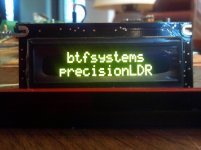 Startup.jpg526.9 KB · Views: 287
Startup.jpg526.9 KB · Views: 287 -
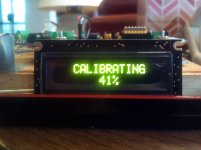 Calibrating.jpg582.4 KB · Views: 282
Calibrating.jpg582.4 KB · Views: 282 -
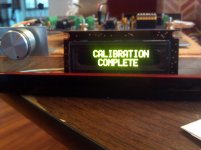 CalibrationComplete.jpg598 KB · Views: 277
CalibrationComplete.jpg598 KB · Views: 277 -
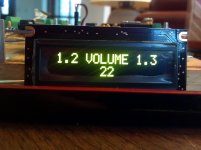 Volume with milliamps.jpg541.9 KB · Views: 77
Volume with milliamps.jpg541.9 KB · Views: 77 -
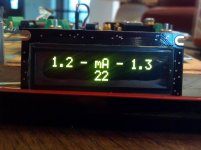 MilliampMode.jpg543 KB · Views: 258
MilliampMode.jpg543 KB · Views: 258 -
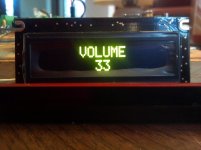 Volume.jpg510.2 KB · Views: 272
Volume.jpg510.2 KB · Views: 272 -
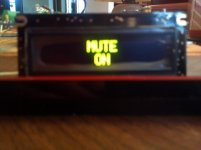 MuteOn.jpg483 KB · Views: 64
MuteOn.jpg483 KB · Views: 64 -
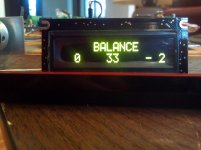 BalanceMode.jpg567.9 KB · Views: 64
BalanceMode.jpg567.9 KB · Views: 64 -
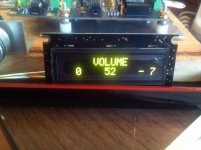 Volume & Offset.jpg567 KB · Views: 74
Volume & Offset.jpg567 KB · Views: 74
Last edited:
Hello Wapo,
nice to see finalization of the system.
If you don't mind me asking, a small question :
when you display the current through the Led's it is not clear to me if it is for shunt or series LDR and both channels. I suppose it will be indicated in the user manual.
On the last sentence I understand that the volume level wanders over the screen if I have understood this correctly.
Personally I would prefer a static indication when I'm lissen to music (other persons may enjoy this though)
Best regards,
Edwin
nice to see finalization of the system.
If you don't mind me asking, a small question :
when you display the current through the Led's it is not clear to me if it is for shunt or series LDR and both channels. I suppose it will be indicated in the user manual.
On the last sentence I understand that the volume level wanders over the screen if I have understood this correctly.
Personally I would prefer a static indication when I'm lissen to music (other persons may enjoy this though)
Best regards,
Edwin
- Status
- This old topic is closed. If you want to reopen this topic, contact a moderator using the "Report Post" button.
- Home
- Source & Line
- Analog Line Level
- A precision LED/LDR-based Attenuator
